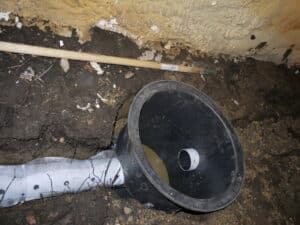The Importance of Basement Drainage System Installation by Professionals
A dry and secure basement is crucial for maintaining the structural integrity and comfort of your home. If you’ve ever experienced a wet, leaky basement, you understand the stress and inconvenience it can bring. This is where professional basement drainage system installation comes into play. In this article, we will explore what basement drainage systems are, why they are important, and why it’s essential to hire professionals for their installation.
What is a Basement Drainage System?
A basement drainage system is a set of specialized components, structures, and techniques designed to prevent moisture from infiltrating your basement. It serves as a robust defense against water seepage and flooding, ensuring your basement stays dry, safe, and comfortable.
Why is Basement Drainage Important?
Basement drainage is a critical aspect of home maintenance
1. Prevents Structural Damage: Excess moisture in your basement can wreak havoc on your home’s foundation and structure. Water infiltration can lead to cracks, deterioration of concrete, and compromised structural integrity. Over time, these issues can result in costly repairs or even pose safety hazards.
2. Mitigates Mold and Mildew: Moisture is a breeding ground for mold and mildew. Mold spores can flourish in damp environments and quickly spread throughout your home. Besides being unsightly, mold can trigger health problems such as allergies, asthma, and respiratory issues in your family.
3. Protects Valuables: Many homeowners use their basements for storage. If your basement is prone to moisture, valuable possessions like furniture, electronics, documents, and sentimental items can be damaged or ruined. A proper drainage system helps safeguard your belongings.
4. Enhances Indoor Air Quality: A damp basement can introduce excess humidity into your home, which can degrade indoor air quality. Poor air quality can exacerbate respiratory problems and cause discomfort for your family.
5. Preserves Property Value: Homes with dry, well-maintained basements are more appealing to buyers. Installing a basement drainage system not only protects your home but also maintains or increases its resale value.
6. Reduces Energy Costs: Basements with excess water and high humidity levels require more energy to heat and cool. By eliminating excess moisture, a basement drainage system can contribute to energy efficiency, lowering your utility bills.
7. Prevents Flooding: A functional basement drainage system with underground pipes, including a sump pump, acts as a first line of defense against flooding. It can efficiently pump out water during heavy rains or if groundwater levels rise, preventing costly and disruptive basement floods.
8. Avoids Pest Infestations: Damp basements are inviting environments for pests like termites and cockroaches. By keeping dirty water in your basement dry, you discourage these unwanted intruders.
9. Increases Usable Space: A dry basement can be a valuable extension of your living space. Whether you want to finish your basement for additional rooms or simply use it for storage, a moisture-free environment is a must for maximizing its potential.
10. Reduces Stress and Worry: Knowing that a reliable drainage and sewer system protects your basement also provides peace of mind. You won’t have to constantly worry about water damage or the associated expenses and inconveniences.
In summary, basement drainage is not just about keeping your basement dry; it’s about safeguarding your home, your health, and your investments. The long-term benefits of a well-designed basement drainage system far outweigh the initial cost, ensuring that your home remains a secure and comfortable place for years to come. Don’t wait until moisture-related problems arise; invest in basement drainage today to protect your home and your family’s well-being.
Why Hire Professionals for Basement Drainage System Installation?
While DIY projects can be appealing, basement drainage system installation is a complex and crucial task that should be left to professionals. Here’s why:
Expertise: Professional installers have the knowledge, skills, and experience required to assess your specific situation and determine the most effective drainage system for standing water in your basement.
Custom Solutions: Every basement is unique, and a one-size-fits-all approach won’t work. Professionals tailor the system to address your basement’s specific issues, ensuring optimal performance.
Quality Materials: Professionals have access to high-quality waterproofing products various components and systems that may not be available to the average homeowner. These materials offer superior protection and durability.
Code Compliance: Basement drainage installation often involves compliance with local building codes. Professionals are well-versed in these regulations and ensure your project meets all necessary standards.
Warranty and Guarantee: Reputable professionals offer warranties and guarantees on their work, giving you peace of mind that your investment is protected.
Types of Basement Drainage Systems:
Basement drainage systems come in various types, each tailored to address specific moisture-related issues in your basement. These systems can be broadly categorized into interior and exterior solutions, offering comprehensive protection against water infiltration and ensuring a dry and secure environment. Let’s delve deeper into the different types of basement drainage systems:
1. Interior Basement Waterproofing:
Interior drainage systems are designed to manage moisture that penetrates the basement from the inside. They are highly effective for addressing issues like water seepage through basement walls or the floor, especially in areas where the water table is high. Here are some key components of interior basement waterproofing:
Perimeter Drainage Channel: A trench or channel is installed along the interior perimeter of the basement floor. It collects water that enters through cracks in the walls or floor.
Sump Pump: A sump pump is placed in a pit (sump basin) within the basement. It activates when water reaches a certain level in the pit and pumps the collected water out of the basement, preventing flooding.
Weeping Tile or Drain Tile: A perforated pipe, known as weeping tile or drain tile, is installed around the perimeter of the foundation. It collects groundwater and directs it to the sump pump or perimeter drainage channel.
Cove Drain: Cove drains are specifically designed to manage water infiltration at the junction where the basement floor meets the wall. They prevent moisture from seeping in at this vulnerable point.
2. Exterior Basement Waterproofing:
Exterior basement waterproofing systems are installed on the outside of the foundation walls to prevent water from reaching the basement in the first place. These systems are effective against surface water, groundwater, and hydrostatic pressure. Here are the key components of exterior basement waterproofing:
French Drain: A French drain is a trench-shaped well filled with gravel or a perforated pipe that is installed outside the foundation walls. It intercepts the flow and redirects groundwater away from the foundation.
Catch Basins: Catch basins are collection points for surface water on your property. They are connected to drainage or sewer and pipes that channel water away from low-lying areas, preventing it from accumulating near your foundation.
“J” Drain: “J” drains, also known as curtain drains, are installed near the top of the slope of the foundation walls to intercept surface water runoff and direct it away from the basement.
Downspout Extensions: Extending downspouts ensures that rainwater from your roof or gutter system is discharged far enough away from your home’s foundation, reducing the risk of water intrusion.
Stair Landing Drains: These drains are strategically placed to redirect rainwater away from stair landings and entryways, preventing moisture from seeping into your home.
Driveway Drains: Driveway drains channel water away from your driveway, preventing it and debris from accumulating along your foundation wall.
3. Combined Interior and Exterior Systems:
In some cases, a combination of interior and exterior drainage systems may be the most effective solution. This comprehensive approach tackles moisture infiltration from the soil on the ground surface on both sides, providing maximum protection against basement water issues.
Choosing the right type of basement drainage system depends on factors such as the source of moisture, the local water table, and the specific characteristics of your basement. Consulting with a professional basement waterproofing expert is essential to determine the most suitable solution for your home. A properly installed basement drainage system ensures a dry, secure, and comfortable living space for you and your family.
Wrap-Up: Invest in Your Home’s Well-Being
In this comprehensive guide, we’ve explored the world of basement drainage systems, shedding light on their paramount importance in
Basement drainage systems come in various forms, each designed to tackle specific moisture-related challenges. Interior systems, including perimeter drainage channels, sump pumps, weeping tiles, and cove drains, provide effective solutions for managing water that infiltrates your basement from within. Exterior systems, such as French drains, catch basins, “J” drains, downspout extensions, stair landing drains, and driveway drains, offer proactive defense against water intrusion from the outside.
The choice of the right basement drainage system depends on the unique characteristics of your home, the nature of the moisture issues, and your local environmental factors. Consulting with professionals who specialize in basement waterproofing is essential to ensure that you receive a tailored solution that fits your needs.
Investing in a basement drainage system is an investment in your home’s longevity, value, and your family’s well-being. It guards against structural damage, mold growth, and health hazards while preserving your property’s integrity and marketability. A dry basement is not just a physical space; it’s a testament to your commitment to a safe and comfortable living environment.
So, whether you’re looking to prevent potential water problems now, seeking to enhance your home’s energy efficiency, or aiming to expand your usable living space, a well-designed basement drainage system is your first line of defense. Embrace the peace of mind that comes with knowing your home is protected from moisture and sewer-related issues, and take action today to secure your family’s future and your property’s value.

Seal-tite Basement Waterproofing Co. is a full service basement environment contractor. We carry an A+ Better Business Bureau rating. We repaired over 40,000 homes and structures in Virginia, West Virginia, Tennessee, and North Carolina. We are fully insured and licensed. We have worked in all types of locations, including residential and commercial locations, government agencies, colleges, hospitals, churches, and condo associations.
Seal-tite® offers a lifetime transferable warranty. We carry a Class A Contractor’s License and we are fully insured. Our satisfied customers range from government agencies to businesses, hospitals, colleges, churches, and thousands of homeowners. Your home is probably the single largest investment you will make in your lifetime. Don’t wait, call Seal-tite® to help make your home dry, safe and livable.
 Call or email for a free estimate. For immediate help call
Call or email for a free estimate. For immediate help call  Start with trust. We’re BBB A+ Rated The Top Satisfaction Rate Awarded.
Start with trust. We’re BBB A+ Rated The Top Satisfaction Rate Awarded.